An evening with the Rauch Brothers
Article by Caresse Singh.
I had known Mike Rauch for a while from ASIFA events and he’d always struck me as a down to Earth, relatable and approachable guy. I learnt even more about him and his brother, Tim, at the April 20th ASIFA event, which shined a spotlight on the Rauch Brothers. Listening to them talk (sometimes interrupting each other) made me laugh to myself as I fondly remembered creative endeavors with my own sisters. Their bond as brothers, they’ve admitted, is a big part of why the Rauch Brothers have managed to stay strong as creative partners. The Rauch Brothers techniques, positive attitude and open mindedness have helped them to gain success in an industry so often full of technical, creative and monetary limitations.
For those few of you who don’t know the Rauch Brothers, they are the masterminds behind the animated shorts at StoryCorps. To find out more about their history, check out their website at www.rauchbrothers.com. In their presentation at the ASIFA event, they went into depth about their development process and the various lessons they’ve learnt. What they explained revealed them to be creative problem solvers, who, instead of playing victim to exigent circumstances, worked every angle life threw at them to their advantage.
The way StoryCorps operates involves the first step of recording real life stories from the actual people who lived them. It’s easy for any filmmaker to see how this can be a tricky situation. The brothers do comb through the stories and admit that many of them cannot be used for their animations. For the Rauch Brothers, choosing a story, is less about going with an emotion and instead considering “why does this need to be animated?” They resist the urge to edit the audio in any way. “Working within parameters forces you to come up with a creative solution,” said Mike, “maybe one day we will change the audio but for now it works.” The brothers are sure to meet everyone they draw and they attempt to keep it as close to reality as possible without drowning the film with details irrelevant to the plot. They aimed to make every film visually different from each other, to make each story as unique as the people who told it.
The type of research that goes behind each story usually differs as well. For “Germans in the Woods” the brothers filled their minds with historical context, while “Q & A” was more of a study in behavior.
While “Germans in the Woods,” was met with polite applause at screenings, their second film, “Q. & A.” was far better received at both Annecy and Ottawa festivals. Still, they highly value their first film. It spoke to and about a group of people who aren’t often empathized with in animated films, and that is Veterans with PTSD. “It was great to make a film that was more for something than just a laugh,” said Tim, “there was a use for it.”
By 2009, Mike was laid off from his job. Though of course it was a disappointment, he took advantage of his newly found free time by building a website and attending film festivals. “Sure sometimes it was hard to come by the money to get to these festivals,” Mike explained, “Somehow I managed with what I had saved.”
“Danny & Annie” was the first Rauch Brothers film funded by the CPB. Tim expressed being especially happy about the fact that he could now pay someone to do the backgrounds. “I hated doing backgrounds,” Tim recalls. By recognizing their weaknesses, the Rauch Brothers were able to ensure that every aspect of their films received the expert attention it needed.
To create a truly personalized film, the Rauch Brothers sought to include many details of the real story, such as the fact that Danny had whiskey and Annie had wine on their first date. Not everything made the final cut, however, the fat had to be trimmed to include only what was relevant so as to guide the story in a specific direction. “We’d attempt to draw every single thing in the living room for example,” Mike said, “but then our background painter Bill Wray reminded us that sometimes less is more. Now our backgrounds are carefully crafted so that the details we add help support the story, instead of adding detail for detail’s sake.
The brothers described their willingness to listen to the people they worked with and in the end the compromises paid off. “Sometimes, of course, we’d push back,” Mike assured but went on to express faith in the process of collaboration and mutual respect.
Another stand out aspect of the Rauch Brother’s work is that by design, it defies the traditions audience members have come to expect of animated films. With “Danny and Annie,” the rather neutral palette, and minimal art style was reflective of the simple, sweet and all together heartwarming romance shared by the real life couple.
It would appear they choose stories not just on how unique they are, but also what they can do with that story both to enrich the memory of it and to stretch the limits of what animation can successfully pull off.
Certainly, when watching the characters of Danny & Annie for the first time, you expect that it’s going to be humorous. People often associate cartoons with humor and animators are often afraid of appearing too serious. The Rauch Brothers bravely allow themselves to explore darker, less talked about areas of the human experience, without trying too hard to elicit any specific emotional response. There is a visible and genuine heart behind the work produced by the Rauch Brothers.





